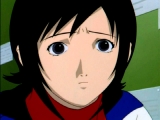

Quick Links:
Serial Experiments Lain, Volume 1: Navi
Serial Experiments Lain is an exercise in humility. That is to say, you will be humbled by how much it makes your brain hurt. The early episodes are full of confusing and seemingly random statements, coupled with seemingly senseless scenes. The dialogue is convoluted and partially misleading, and the main character only speaks when there's an opportunity to confuse you further. In other words, it's a beautiful work of contemporary fine art. Fear not, friends, for there is a pattern in the chaos. It's hidden in the disjointed speech, the sound effects, and the artwork. The truth is, Lain is a masterpiece. You just don't find that out right away. It's not a show for everyone, but there isn't a specified group of people who should avoid it either. It's a highly personal experience, so one person's enjoyment doesn't accurately predict another's. This set of reviews will explore a bit into each episode, as every episode presents a new (sometimes entirely different) idea, which is then tied into the show's overall premise. Don't worry, there will be no spoilers involved.
The first episode of Lain is appropriately titled "Weird". It opens with the suicide of Chisa Yomoda, a junior-high student. The main character of the show is Lain Iwakura, a 13 year-old girl who goes to the same school. At the school, one of her classmates is crying, because she received an e-mail from Chisa, who is supposed to be dead. In fact, several students at the school received the letter. Also introduced in the first episode is Alice (pronounced "ah-ree su" in the Japanese track), the only classmate of Lain who will talk to her. The predominant theme in "Weird" is death. The first episode doesn't exactly set the stage as much as throw you into a pit of hungry dogs.
A few recurring elements are introduced in this episode. First is the inexplicable bear suit. Lain is shown wearing this several times throughout the show. Other things worth taking note of are the visuals when there is no dialogue. The mess of wires above the streets are often shown, sometimes directly and sometimes as a reflection off of other parts of the scene. Also, the scenes where Lain is by herself are usually rather empty, and the colors used are very much out of the ordinary.
The second episode, "Girls" is somewhat of a stage-setter for events to come. Lain receives a new computer, called a Navi. You could say Navi is similar to an E-machine. Their 'internet' is called "the Wired". From the beginning of the series, it's apparent that Lain knows very little about computers, which makes later events all the more interesting. The new element introduced in "Girls" is the drug Accela (which supposedly makes the user's mind work faster), and the club Cyberia, a dance club that young people go to. Lain is invited to go to Cyberia with Alice and her friends.
Episode 3, "Psyche", has to do with connections. Lain receives a new processing chip as a gift from an anonymous person, and later finds out that it's a "psyche" chip. Much in the way a person's psyche serves as a connection to the subconscious, the psyche chip is a connection to the wired. This is no ordinary connection, however.
Episode 4, "Religion", is an introduction to the Knights. Knights are suspected to be a group of hackers, but nobody really knows anything about them. They have a commanding presence in the wired, and always seem to be stirring up trouble. The latest thing is the tampering with a networked shooter game, causing it to be somehow linked to a children's game called Phantoma. Meanwhile, there are more mysterious deaths.
Much of Lain's music in the beginning is fairly empty, using primitive rhythms and few instruments. In fact, it's difficult to even call it music. On the other hand, the opening song "Duvet" (courtesy of Boa) is beautiful. It's soothing and mesmerizing, with a guitar sound which is both soft and sweet. Jasmine Rodgers' voice is equally sweet and mesmerizing in this song. In a hypothetical race for best anime opening song, "Duvet" would win with ease. It's that good. By contrast the closing song for the show, "Far Shout" is somewhat harsh and isn't very inspiring. Its rhythm does fit fairly well with the show, however.
The animation for the series is near perfect. All motion, transitions, and pans are smooth as silk. In particular, the staging of the show is marvelous. There's never a question as to which object has the focus in the scene. The backgrounds are simple and the subject is highly detailed. The character designs are equally well done. They are done in a rather unique style, which sets the show apart from other anime. Lain's design is especially interesting, because she takes on many different appearances, with little change to the drawing. For instance, sometimes she looks like a doll or marionette, and other times she appears to be full of life. Her eyes take on different appearances as well, sometimes being clear like other characters', and other times having hard lines (wires, perhaps?) through the pupils. Changes in Lain aren't always easily noticeable, so a lot can be missed if you don't pay close attention.
The transfer & localization for Lain is a prime example of what Pioneer is capable of. The video quality is incredibly clear and clean, as is the audio. The most impressive thing about the localization is the English dub track. Pioneer did an exceptional job with this, matching lip movements and providing a script that both makes sense and fits the show's characters. The one complaint I have about the localization is in the subtitling. Alice is referred to as Arisu in the subtitles. There should have been some consistency here, either by pronouncing her name as Arisu in the dub, or by calling her Alice in the subtitles. Language selection is the standard fare, with tracks in English and Japanese. The menus on the dvd are nicely done, and easily navigated. Extras on the dvd include an image gallery with conceptual drawings, and promotional videos for "Duvet" and "Far Shout".
Should you watch Lain? Unfortunately, the first volume doesn't have enough information to effectively make that decision. However, there are enough interesting details at the show's beginning to warrant further inquiry. Shall we continue?
Distributor: Pioneer Animation Creator: Triangle Staff / Pioneer LDC Released: 1998
Video Quality: A+ Audio Quality: A+ Presentation: A- Content: B- Overall: B+



